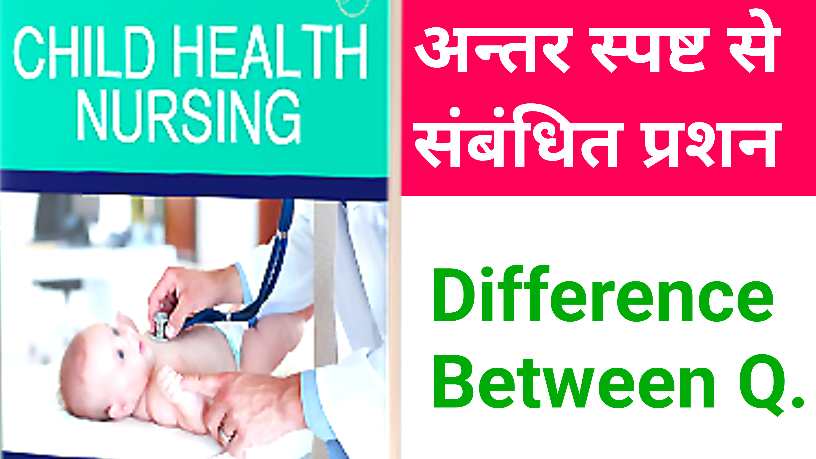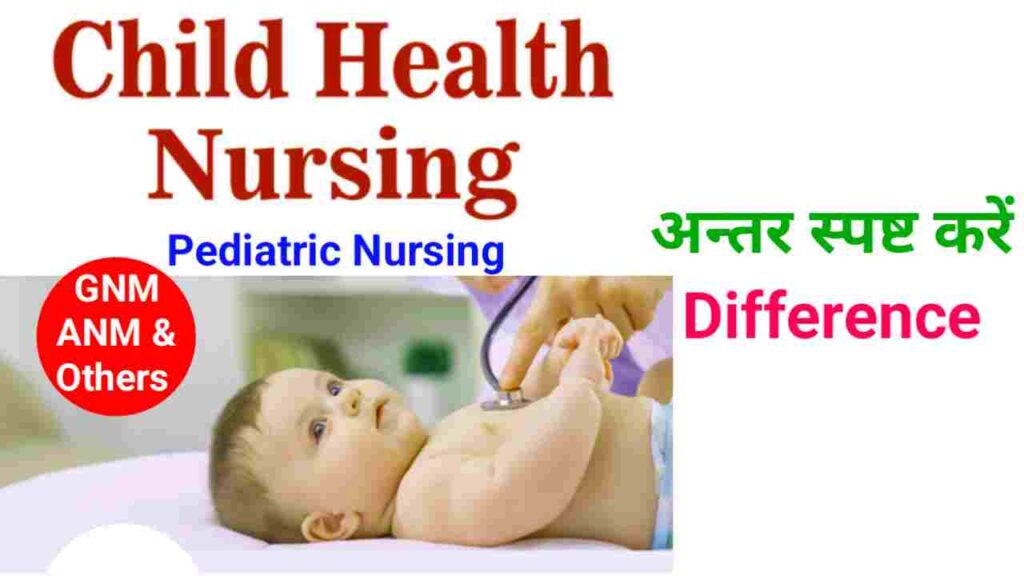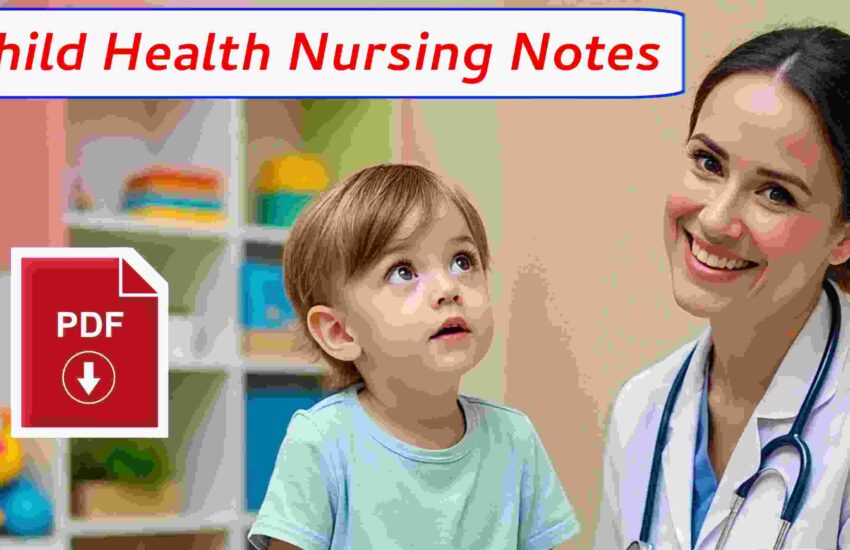Child Health & Pediatrics Nursing अन्तर स्पष्ट करें (Difference Between) – child health nursing notes pdf For ANM, GNM 2nd Year, Bsc Nursing & Others:-
Child Health & Pediatrics Nursing अन्तर स्पष्ट करें (Difference Between) – child health nursing notes pdf For ANM, GNM 2nd Year, Bsc Nursing & Others:-
child health nursing definition child health nursing in hindi.child health nursing notes pdf.child health nursing book child health nursing assignment child health nursing assignment topics child health nursing care plan pdf child health nursing pdf in hindi चाइल्ड हेल्थ नर्सिंग
anm nursing pdf anm gnm book pdf anm gnm pyq pdf anm gnm 2023 syllabus pdf anm gnm question paper pdf anm gnm omr sheet pdf anm gnm notification 2023 pdf anm gnm practice set pdf, anm gnm book 2023 pdf download

✓कैपुट सक्सिडेनियम तथा शीर्ष रक्तगुमठा (रक्तगुल्म) में अंतर
(Difference between Caput Succedaneum and Cephalhaematoma)
कैपुट सक्सिडेनियम( Caput Succedaneum )
1. यह शिशु के सिर पर पाई जाने वाली जलशोथिय सूजन है।
2. यह शिरोवल्क ऊतक में रक्त युक्त लसीय द्रव के भर जाने के कारण होती है।
3. यह जन्म के समय से ही उपस्थित होती है व जन्म के 36 घंटों में विलुप्त हो जाती है।
4. इसे दबाने पर गड्ढा बन जाता है।
5. यह सीवन रेखा के दूसरी ओर जा सकती है।
1. This is a hydrostatic swelling found on the head of the baby.
2. It occurs due to filling of lymphatic fluid containing blood in the cerebral tissue.
3. It is present from the time of birth and disappears within 36 hours of birth.
4. When pressed, a crater is formed.
5. It may go to the other side of the seam line.
शीर्ष रक्तगुमठा (रक्तगुल्म )apex hematoma
1. यह शिशु के सिर पर पाई जाने वाली सूजन है।
2. यह जन्म के दौरान सिर और श्रोणि में रगड़ के कारण पैरिओस्टीयम के नीचे रक्त भरने के कारण होता है।
3. इसमें उपचार की आवश्यकता नहीं होती है व रक्त अवशोषित कर लिया जाता है व सूजन खत्म हो जाती है।
4. इसे दबाने पर गड्ढा नहीं बनता है।
5. यह सीवन रेखा के उस पार कभी नहीं जाती है।
1. This is a swelling found on the head of the baby.
2. It is caused by blood filling under the periosteum due to rubbing of the head and pelvis during birth.
3. It does not require treatment and the blood is absorbed and the swelling goes away.
4. It does not form a crater when pressed.
5. It never goes beyond the seam line.
✓मोरो प्रतिवर्त तथा पकड़ प्रतिवर्त में अंतर
(Difference between Moro Reflex and Grasp Reflex)
मोरो प्रतिवर्त
1. यह शिशु के जन्म से तीन माह तक पाया जाता है।
2. मोरो प्रतिवर्त शिशु को अचानक डराने या चौंकाने से उत्पन्न होता है।
3. इसमें शिशु के दोनों हाथ ऊपर व बाहर की ओर फैलते हैं।
4. शिशु दोनों पैर उठा लेता है व अंगूठे व तर्जनी उंगुली से C आकार बना लेता है।
5. इसे वैस्टीबुलर रिफ्लैक्स भी कहा जाता है।
1. It is found from the birth of the baby till three months.
2. Moro reflex is produced by suddenly scaring or startling the baby.
3. In this, both the hands of the baby spread upwards and outwards.
4. The infant lifts both feet and forms a C shape with the thumb and index finger.
5. It is also called vestibular reflex.
पकड़ प्रतिवर्त
1. यह शिशु के जन्म से 12 सप्ताह तक पाया जाता है।
2. शिशु के हथेली या तलवे को छूने या रगड़ने से यह प्रतिवर्त उत्पन्न होता है।
3. शिशु हाथों से अंगुली को कसकर पकड़ लेता है।
4. इसमें शिशु का तलवा चापीय (arc) रूप ले लेता है तथा अंगूठा नीचे की ओर मुड़ जाता है।
5. इसे ड्रॉनियन रिफ्लैक्स (drawinian reflex) भी कहते हैं।
1. It is found from the birth of the baby till 12 weeks.
2. This reflex is produced by touching or rubbing the palm or sole of the baby.
3. The baby holds the finger tightly with his hands.
4. In this, the sole of the baby takes an arc form and the thumb turns downwards.
5. It is also called drawinian reflex.
✓श्वसन नली विस्तारण तथा श्वसन नली शोथ में अन्तर (Difference between Bronchiolitis and Bronchiectasis)
श्वसन नली विस्तारण
1. यह ऐसी अवस्था है जिसमें श्वसनिकाओं का दीर्घकालीन विस्तारण हो जाता है अथवा नष्ट हो जाती हैं।
2. तेज श्वॉस चलता है व श्वाँस कष्ट होता है।
3. इसमें लगातार खांसी आती है व रक्त भी आता है।
4. ऑक्सीजन थैरेपी दी जाती है।
5. एन्टीबायोटिक्स दिए जाते हैं।
6. श्वसन व्यायाम कराए जाते हैं।
trachea dilatation
1. This is a condition in which the bronchi become chronically expanded or destroyed.
2. There is rapid breathing and difficulty in breathing.
3. There is continuous cough and blood also comes in it.
4. Oxygen therapy is given.
5. Antibiotics are given.
6. Respiratory exercises are done.
श्वसन नली शोथ
1. यह नवजात व बच्चों में होने वाला फेफड़ों का संक्रमण है। इसमें ब्रोंकियल्स का प्रदाह हो जाता है।
2. दुर्गंध युक्त श्वॉस आती है।
3. इसमें पस युक्त मवाद निकलता है।
4. नाक बहती रहती है व तेज श्वॉस चलता है।
5. 3 माह से 2 वर्ष तक के बच्चों में अधिक पाया जाता है।
6. एन्टीबायोटिक्स दिए जाते हैं व श्वसन व्यायाम कराया जाता है।
respiratory tract inflammation
1. This is a lung infection occurring in newborns and children. In this, inflammation of the bronchial tubes occurs.
2. There is foul smelling breath.
3. Pus containing pus comes out in it.
4. The nose keeps running and there is heavy breathing.
5. It is found more in children between 3 months to 2 years.
6. Antibiotics are given and respiratory exercises are done.

✓केर्निग्स चिन्ह एवं ब्रुजिंस्किज चिन्ह में अन्तर (Difference between Kernig’s Sign and Brudzinski’s Sign)
केर्निग्स चिन्ह
1. यह मंनिन्जाइटिस का नैदानिक चिन्ह है।
2. मेनिन्जाइटिस मस्तिष्कावरण के शोथ को कहते हैं।
3. क्रेनिंग्ग्य चिन्ह का परीक्षण करने के लिए व्यक्ति को पीठ के वन्न लिटाकर जांघ को शरीर पर आकुंचित कर टांगों को प्रसाग्नि करने पर दर्द होता है इसे ही केर्निग्स चिन्ह कहते हैं।
Kernigs sign
1. This is a clinical sign of meningitis.
2. Meningitis is inflammation of the meninges.
3. To test Krennig’s sign, a person feels pain by lying on his back and flexing his thighs and extending his legs, this is called Krennig’s sign.
ब्रुजिंस्किज चिन्ह
1. यह भी मेनिन्जाईटिस का नैदानिक चिन्ह है।
2. इसमें रोगी की गर्दन, कूल्हों व घुटनों में गंभीर रूप से अकड़न होती है।
3. ब्रुजिंस्किज चिन्ह का परीक्षण करने के लिए व्यक्ति को पीठ के बल लिटाकर गर्दन व घुटनों को आकुंचित किया जाता है गंभीर अकड़न महसूस होना ही ब्रुजिस्किज चिन्ह कहलाता है।
Brujinskij sign
1. This is also a clinical sign of meningitis.
2. In this, the patient has severe stiffness in his neck, hips and knees.
3. To test the Bruzinski sign, the person is made to lie on his back and the neck and knees are contracted. Feeling severe stiffness is called the Bruzinski sign.
✓अधोमूत्रमार्गता तथा अधिमूत्रमार्गता में अन्तर (Difference between Hypospadias and Epispadias)
अधोमूत्रमार्गता (Hypospadias)
1. यह शिश्न के निचले पृष्ठ पर कहीं पर हो सकता है।
2. नर शिशु में मूत्र नीचे व पीछे की ओर निकलता है।
3. मादा शिशु में मूत्र योनि से होकर बाहर निकलता है।
4. मूत्रत्याग के लिए शिश्न को खड़ी स्थिति में रखना पड़ता है।
1. It may occur somewhere on the lower surface of the penis.
2. In a male child, urine comes out downwards and backwards.
3. In female babies, urine comes out through the vagina.
4. For urination, the penis has to be kept in an erect position.
अधिमूत्रमार्गता (Epispadias)
1. यह शिश्न के ऊपरी पृष्ठ पर कहीं भी हो सकता है।
2. नर शिशु में मूत्र ऊपर की ओर निकलता है।
3. मादा शिशु में क्लाइटोरिस के आस-पास से निकलता है।
4. मूत्रत्याग के लिए शिश्न को खड़ी स्थिति में नहीं रखना पड़ता है।
1. It can occur anywhere on the upper surface of the penis.
2. In a male child, urine comes out upwards.
3. Originates from around the clitoris in female infants.
4. The penis does not have to be kept in an erect position for urination.
✓जलीय मधुमेह तथा मधुमेह में अन्तर
(Difference between Diabetes Insipidus and Diabetes Mellitus)
जलीय मधुमेह (Diabetes Insipidus)
1. यह एन्टीडायूरेटिक हार्मोन (ADH) की कमी के कारण होता है।
2. इसका मुख्य लक्षण बहुमूत्रता (polyuria) व अत्यधिक प्यास (polydipsia) लगना है।
3. यह गुर्दा रोग का मुख्य कारण होता है।
1. It is caused by deficiency of antidiuretic hormone (ADH).
2. Its main symptoms are polyuria and excessive thirst (polydipsia).
3. It is the main cause of kidney disease.
मधुमेह (Diabetes Mellitus)
1. इंसुलिन की मात्रा में कमी होने के कारण या इसके प्रभावहीन होने से मधुमेह उत्पन्न होता है।
2. इसमें इंसुलिन कार्बोहाइड्रेट, प्रोटीन एवं वसा के चयापचय में विकार उत्पन्न हो जाता है।
3. मधुमेह की कई प्रकार की जटिलताएं होती हैं जैसे- गुर्दा रोग, हृदय रोग आदि।
1. Diabetes occurs due to decrease in the amount of insulin or its ineffectiveness.
2. In this, insulin causes disorders in the metabolism of carbohydrates, proteins and fats.
3. There are many types of complications of diabetes like kidney disease, heart disease etc.
✓वृद्धि तथा विकास में अन्तर (Difference between Growth and Development)
वृद्धि (Growth)
1. वृद्धि से तात्पर्य है आकार, संख्या व द्रव्यमान का बढ़ना।
2. वृद्धि से नए-नए अंगों का निर्माण होता है।
3. वृद्धि को इंच, सेटीमीटर, वजन में मापा जाता है।
1. Growth means increase in size, number and mass.
2. Growth leads to formation of new organs.
3. Growth is measured in inches, centimeters, weight.
विकास (Development)
1. विकास से तात्पर्य शारीरिक क्रियाओं के निरंतर बढ़ने से है।
2. अंगों में नए-नए कार्य उत्पन्न होते हैं।
3. विकास को शरीर की कार्यक्षमता से मापा जाता है।
1. Development means continuous increase of physical functions.
2. New functions are generated in the organs.
3. Development is measured by the functionality of the body.
✓सम्पूरक पोषण तथा पूरक पोषण में अन्तर (Difference between Complementary Nutrition and Supplementary Nutrition)
सम्पूरक पोषण
व्यक्ति के शरीर किसी विशिष्ट तत्व की कमी होने पर उस तत्व की पूर्ति करने के लिए दिया जाने वाला पोषण सम्पूरक पोषण कहलाता है जैसे- कैल्शियम की कमी होने पर कैल्शियम युक्त भोजन व दवाई देना।
When there is a deficiency of a specific element in a person’s body, the nutrition given to compensate for that element is called supplementary nutrition. For example, in case of calcium deficiency, giving calcium-rich food and medicine.
पूरक पोषण
शरीर के लिए जरूरी सभी आवश्यक तत्वों की पूर्ति के लिए दिया जाने वाला पोषण पूरक पोषण कहलाता है जैसे- बच्चों को दिए जानी वाले मल्टीविटामिन आहार व दवाईयां।
The nutrition given to supply all the essential elements required by the body is called supplementary nutrition, such as multivitamin food and medicines given to children.
✓पूतिवक्ष तथा वातस्फीति में अन्तर(Difference between Empyema and Emphysema)
पूतिवक्ष (Empyema)
1. प्लूरल केविटी में पस एकत्रित होने को एम्पाइमा कहते हैं।
2. ट्यूबरकुलोसिस, सेप्टिसीमिया, ruptured lung abscess इसके प्रमुख कारण हैं।
3. इसका निदान चैस्ट एक्स-रे व वक्षवेधन (thoracentesis) द्वारा किया जाता है।
4. संक्रमण होने पर एन्टीबायोटिक्स दिए जाते हैं।
5. वाटर सील ड्रेनेज द्वारा पस निकाला जाता है।
1. Collection of pus in the pleural cavity is called empyema.
2. Tuberculosis, septicemia, ruptured lung abscess are its main causes.
3. It is diagnosed by chest X-ray and thoracentesis.
4. Antibiotics are given in case of infection.
5.Pus is removed by water seal drainage.
वातस्फीति (Emphysema)
1. फेफड़ों के ऊतकों में वायु एकत्रित होने को एम्फाइसीमा कहते हैं।
2. सीओपीडी (chronic obstructive pulmonary diseases) इसका प्रमुख कारण हैं।
3. इसका निदान चैस्ट एक्स-रे, पी.एफ.टी., फ्लूरोस्कोपी द्वारा किया जाता है।
4. संक्रमण होने पर एन्टीबायोटिक्स दिए जाते हैं।
5. इसमें ब्रोंकोडायलेटर देते हैं।
1. Accumulation of air in the lung tissue is called emphysema.
2. COPD (chronic obstructive pulmonary diseases) is its main cause.
3. It is diagnosed by chest X-ray, PFT, fluoroscopy.
4. Antibiotics are given in case of infection.
5. Bronchodilators are given in it.
Q. एसाईनोटिक एवं साईनोटिक हार्ट डिसीज़
Acyanotic and cyanotic heart disease
एसाईनोटिक हार्ट डिसीज़ (Acyanotic Heart Disease) –
एसाईनोटिक हार्ट डिसीज़ जन्मजात हृदय विकार है जिसमें रक्त का सामान्य प्रवाह प्रभावित होता है। हृदय भित्ति में छेद एसाईनोटिक हार्ट डिसीज़ का एक उदाहरण है।
Acyanotic heart disease is a congenital heart disorder in which the normal flow of blood is affected. A hole in the heart wall is an example of acyanotic heart disease.
Q. साईनोटिक हार्ट डिसीज़ (Cyanotic Heart Disease) –
साईनोटिक हार्ट डिसीज़ जन्मजात हृदय विकारों के समूह को कहते हैं। इनके कारण रक्त में ऑक्सीजन की मात्रा कम हो जाती है व साइनोसिस (cyanosis) की स्थिति उत्पन्न हो जाती है जिससे त्वचा व म्यूकस मैम्ब्रेन का रंग नीला पड़ जाता है।
Cyanotic heart disease is a group of congenital heart disorders. Due to these, the amount of oxygen in the blood decreases and a condition of cyanosis occurs due to which the color of the skin and mucus membranes turns blue.
Q. स्टटिंग (Stuttering) और क्लटूरिंग (Cluttering)
स्टटिंग (Stuttering) – यह एक बोलने का विकार है जिसमें सामान्य रूप से या धारा प्रवाह रूप में बच्चा नहीं बोल पाता है, इसे हकलाना भी कहते हैं। इसके कारण अज्ञात हैं, परंतु पारिवारिक इतिहास (family history) व घबराहट (nervousness) इसके कारण हो सकते हैं।
This is a speech disorder in which the child is not able to speak normally or fluently, it is also called stuttering. Its causes are unknown, but family history and nervousness can be the reasons for it.
क्लटूरिंग (Cluttering) – क्लट्ररिंग भी एक बोलचाल का विकार है जिसमें बोलने वाला अव्यवस्थित रूप से बोलता है व सुनने वाले को सही से उसकी बात समझ नहीं आती है। इसमें बच्चा अधिक तेजी से बोलता है या अक्षरों को खा जाता है। क्लटूरिंग का पता बच्चे के बड़े होने पर पता चलता है।
Cluttering is also a speech disorder in which the speaker speaks in a disorganized manner and the listener does not understand what he is saying properly. In this the child speaks more rapidly or eats the letters. Cluttering is detected when the child grows up.
अन्य सभी नर्सिंग नोट्स और पिछले कई सालों के प्रशन पत्र के लिए इसी वेबसाईट पर उपलब्ध हैं जाकर अपने Year wise देख सकते हैं। सभी राज्यों के लिए।

